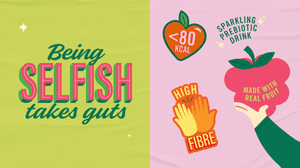
Introduction to Fibre: Everything You Need To Know
Did you know? Only 1 in 4 adults prioritise their gut health (1). A crazy statistic considering 70-80% of our immune tissue is in our gut (2). But, an even crazier statistic is that 90% of the population don’t eat enough fibre (3)!One of the major players that supports our digestion is fibre. Fibre is an essential carbohydrate that the body can’t absorb and digest (4). Unlike other carbohydrates that are broken down into sugar molecules, fibre just passes through the body and helps regulate the body's use of sugars. Without the right amount of fibre we are putting ourselves at higher risk of illnesses and diseases.
According to the NHS, adults should intake at least 30g of fibre a day and most of us are only getting 20g (5).
5 Natural Sources Rich in Fibre
1. Fruits
Raspberries: 1 cup of raspberries has 8g of fibre
Prunes: 30g of prunes contains 2.3g of fibre
Artichoke: A medium artichoke contains 7g of fibre
Avocado:1 cup of avocado has 6.7g of fibre
2. Vegetables
Brussels sprouts: 3.3g of fibre per cup
Kale: contains 4.1g of fibre per cup
Sweet potatoes: 4g of fibre per cup
3. Nuts and Seeds
If you ever find yourself looking for the perfect afternoon snack, grab yourself some mixed nuts and seeds and a can of Selfish and you can help your body get the right amount of fibre!
Almonds: 10g of fibre per 100g
Hazelnuts: 10g of fibre per 100g
Chia Seeds: 34g of fibre per 100g
Pistachios: 10g of fibre per 100g
4. Beans and Legumes
Kidney beans: 25g of fibre per in 100g
Pinto beans: 16g of fibre per 100g
Chickpeas: 12.5g of fibre per cup of cooked chickpeas
Lentils: 13.1g of fibre per cup of cooked lentils
5. Grains
Wholegrain rice: 3.5g in a cup of brown rice
Oats: 16.5g per cup of raw oats
Wholegrain Bread: 2g of fibre in a slice of wheat bread
How Can Selfish Help With Your Fibre Intake?
So how can Selfish support you? Well, each can of Selfish has 5.2 grams of fibre, 19% of the recommended amount from the government. Fibre for each of our gut friendly prebiotic pop comes from chicory root.
Chicory root is from the herbaceous plant, often seen with bright blue flowers. It is well known for being one of the vegetables with the highest fibre content and prebiotic qualities meaning chicory root has many digestive health benefits (6).
Chicory root has been used for hundreds of years, originally native to European countries like the Netherlands, Belgium, France and Germany, it has been a popular plant used for medicinal purposes and sometimes added or substituted to coffee to reduce the bitterness (7).
In addition to its digestive health benefits, chicory root also offers a range of other advantages. It contains a compound called inulin, which acts as a prebiotic, nourishing the beneficial bacteria in our gut (8). By promoting the growth of these good bacteria, chicory root supports a healthy gut microbiome, which plays a crucial role in our overall well-being, from digestion to immune function (9).
Furthermore, chicory root has been studied for its potential anti-inflammatory properties and its ability to aid in weight management by promoting feelings of fullness (10). With its rich history and numerous health benefits, chicory root is a valuable ingredient in Selfish, providing you with a tasty and nutritious beverage option.
What Are Prebiotics?
Prebiotics is essentially just a fancy word for fibre. Prebiotics are essential for your overall health as they improve the balance of microorganisms in your gut which can help certain conditions like IBS (irritable bowel syndrome).
Click here to find out more from our expert blogs.
Tips To Reach Your Recommended Fibre Intake
We understand it can be difficult to adjust your diet to incorporate the right amount of fibre, but there are simple steps you can take. Here’s a full day of eating high fibre meals.
Fibre at Breakfast
2 thick pieces of whole wheat bread
1 avocado
2 eggs
Fibre at Lunch
Jacket potato
Baked beans
1 pear
1 can of selfish
Fibre at Dinner
Lentil curry
Quinoa
Sweet potato
Broccoli
Dark chocolate (70-85% cocoa and avoid ones with lots of added sugar, you’re only damaging your gut!)
These meals will total up to around 57g of fibre, see how easy it is! If you’re looking for a snack, try mixed nuts and wash it down with a Selfish soda to add extra source of fibre to your day to day.
FAQ
What is fibre?
Fibre is a popular form of carbohydrate often found in plant food like fruits, vegetables, beans, nuts and wholegrains. Fibre is an essential part of a healthy diet that our bodies aren't able to digest but is an important player in regulating our body's use of sugar and supporting our digestive system.
How much fibre should I eat a day?
As an adult, the government recommends getting at least 30g of fibre a day. Are you getting enough?
Why is my gut health important?
Your gut can heavily impact your daily life, whether it be your mood, your physical health or your immunity. Issues with gut health can increase the risk of chronic conditions because your gut determines how your body manages the nutrients and minerals from the food you consume and therefore can lead to uncomfortable situations.
How does fibre benefit heart health?
Fibre lowers cholesterol and reduces heart disease risk. Soluble fibre in oats, legumes, and fruits binds cholesterol, leading to lower LDL levels.
Can fibre reduce blood pressure and prevent heart disease?
Yes, a high-fibre diet may lower blood pressure and reduce heart disease risk. Fruits, vegetables, and whole grains support heart health.
Best fibre-rich foods for a healthy heart?
Choose oats, legumes, fruits (apples, berries), and whole grains for heart health and weight management.
How much fibre is needed for a healthy heart?
Aim for at least 30g of fibre daily. Include a variety of fibre-rich foods in your diet.
- Bindels, L. B., Segura Munoz, R. R., Gomes-Neto, J. C., Mutemberezi, V., Martínez, I., Salazar, N., Cody, E. A., Quintero-Villegas, M. I., Kittana, H., de los Reyes-Gavilán, C. G., Schmaltz, R. J., Muccioli, G. G., Walter, J., & Ramer-Tait, A. E. (2017). Resistant starch can improve insulin sensitivity independently of the gut microbiota. Microbiome, 5(1). https://doi.org/10.1186/s40168-017-0230-5
- Dr Laurence Knott. (2017, September 20). Gastroenteritis. Patient.info. https://patient.info/digestive-health/diarrhoea/gastroenteritis
- Harvard School of Public Health. (2018, June 6). Fiber. The Nutrition Source. https://www.hsph.harvard.edu/nutritionsource/carbohydrates/fiber/
- Lotha, G. (2023, May). chicory | Definition, Uses, Cultivation, & Facts. Encyclopedia Britannica. https://www.britannica.com/plant/chicory
- Marie-Luise Puhlmann. (2020, July). Back to the Roots: Revisiting the Use of the Fiber-Rich Cichorium intybusL. Taproots. Bing. https://pubmed.ncbi.nlm.nih.gov/32199025/
- Matos, M. S., Anastácio, J. D., Allwood, J. W., Carregosa, D., Marques, D., Sungurtas, J., McDougall, G. J., Menezes, R., Matias, A. A., Stewart, D., & Dos Santos, C. N. (2020). Assessing the intestinal permeability and anti-inflammatory potential of sesquiterpene lactones from chicory. Nutrients, 12(11), 1–20. https://doi.org/10.3390/nu12113547
- Mosley, B. L. (2022, September). 20+ Gut Health Statistics & Facts (2023). Guthealthimprovement.com. https://guthealthimprovement.com/gut-health-statistics/
- NHS. (2022, July 13). How to get more fibre into your diet. Nhs.uk. https://www.nhs.uk/live-well/eat-well/digestive-health/how-to-get-more-fibre-into-your-diet/
- Public Health England. (2016, September 9). National Diet and Nutrition Survey. GOV.UK. https://www.gov.uk/government/collections/national-diet-and-nutrition-survey
- Sonnenburg, Erica D., & Sonnenburg, Justin L. (2014). Starving our Microbial Self: The Deleterious Consequences of a Diet Deficient in Microbiota-Accessible Carbohydrates. Cell Metabolism, 20(5), 779–786. https://doi.org/10.1016/j.cmet.2014.07.003




